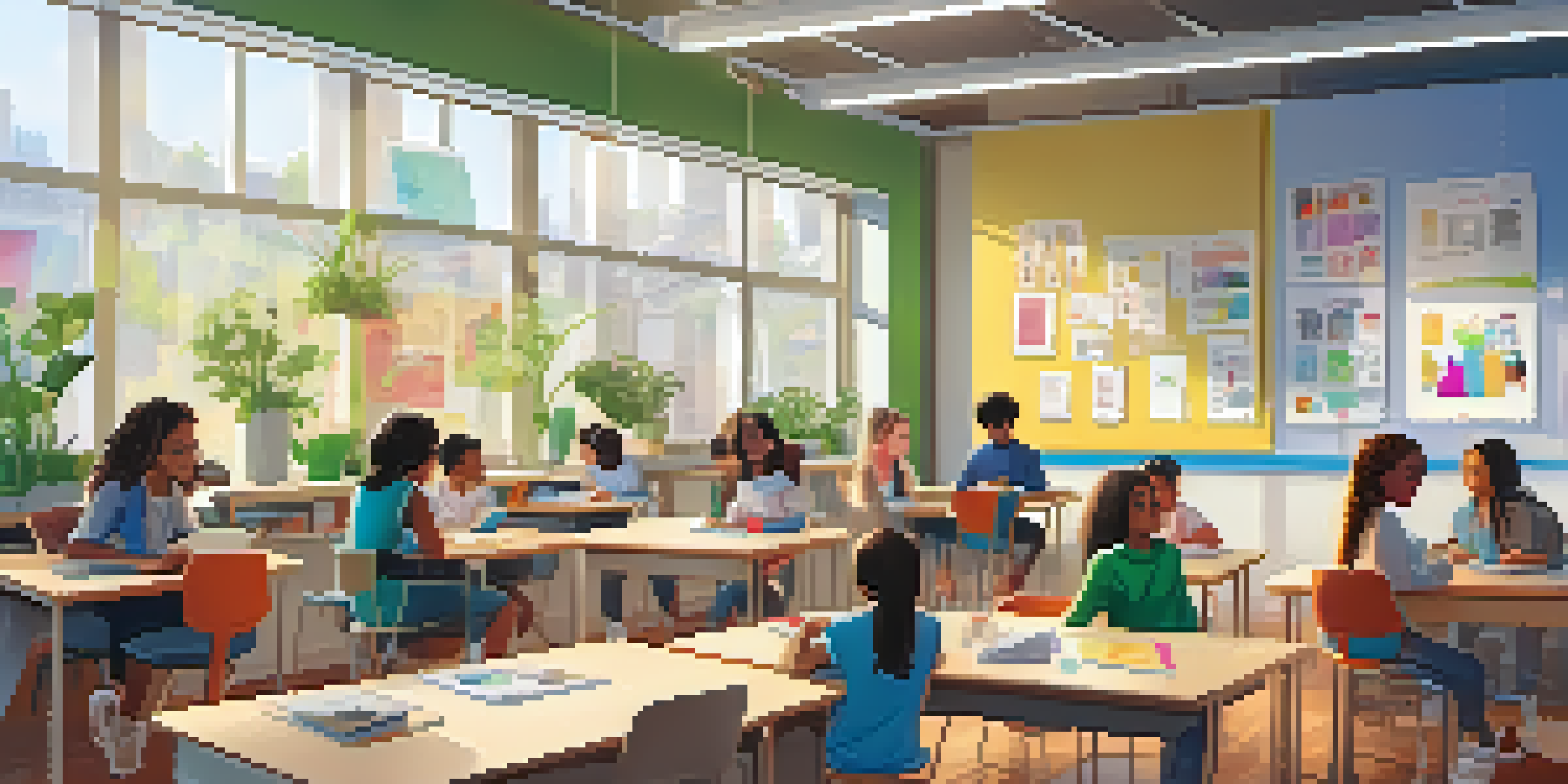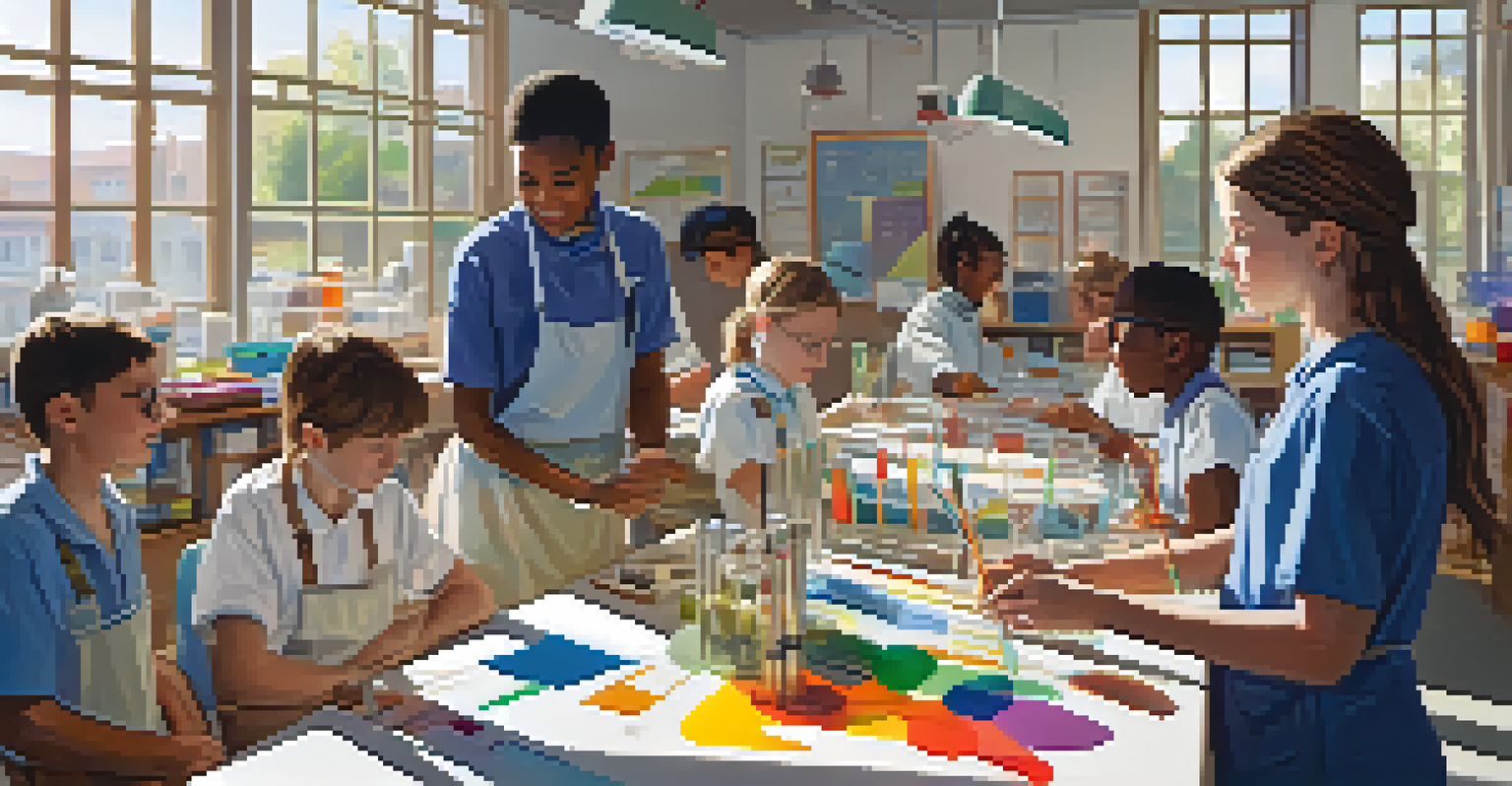Flipped Classroom: Addressing Diverse Learning Styles

Understanding the Flipped Classroom Concept
The flipped classroom model transforms the traditional teaching approach by reversing the typical learning environment. In this setup, students engage with instructional content, often through videos, at home, allowing classroom time for interactive activities. This shift enables educators to provide personalized support and fosters a more hands-on learning experience during class hours.
Education is not the filling of a pail, but the lighting of a fire.
Imagine a typical classroom where students struggle to grasp lessons while being lectured at the front. Now, picture them watching engaging videos at home, absorbing the material at their own pace. This method not only increases comprehension but also empowers students to take charge of their learning journey, making education more accessible and enjoyable.
The flipped classroom isn't just about watching videos; it's about creating a dynamic learning environment where students can ask questions, collaborate with peers, and apply what they've learned. This model sets the stage for deeper understanding and retention, ultimately catering to diverse learning preferences.
The Importance of Diverse Learning Styles
Every student is unique, with individual strengths, weaknesses, and preferences when it comes to learning. Understanding diverse learning styles—such as visual, auditory, and kinesthetic—helps educators create more inclusive and effective teaching strategies. Recognizing these differences is crucial for fostering an engaging classroom environment where all students can thrive.

Take, for instance, a visual learner who benefits from diagrams and videos. If they're confined to traditional lectures, their potential may go untapped. By incorporating varied resources and approaches in a flipped classroom, educators can ensure that students with different learning styles receive the support they need to grasp complex concepts.
Flipped Classrooms Enhance Learning
The flipped classroom model allows students to engage with content at home, enabling interactive and personalized learning during class time.
The goal is to create an educational experience where every student feels valued and understood. When teaching methods align with students' preferred learning styles, it results in increased motivation, participation, and ultimately, academic success.
How the Flipped Classroom Supports Visual Learners
Visual learners thrive on imagery, diagrams, and videos to help them understand new information. In a flipped classroom setting, these learners can watch instructional videos at home, allowing them to absorb the material visually before engaging in hands-on activities during class. This approach enhances their ability to retain information and fosters a deeper understanding of the subject matter.
The only way to learn mathematics is to do mathematics.
For example, a science lesson on the water cycle can be effectively communicated through an animated video, illustrating the process in a way that resonates with visual learners. Once they grasp the concept, class time can be devoted to interactive experiments or group discussions, allowing them to apply their knowledge in a practical context.
By catering to visual learners through the flipped model, educators not only enhance comprehension but also promote creativity and critical thinking. This method encourages students to explore the material from various angles, leading to a richer educational experience.
Engaging Auditory Learners in the Flipped Classroom
Auditory learners absorb information best through listening and discussion. The flipped classroom model can be tailored to meet their needs by incorporating podcasts, audiobooks, and recorded lectures into the learning process. This allows these students to engage with the material in a way that resonates with them, enabling better retention and understanding.
Consider a history lesson where students listen to a well-narrated podcast covering key events. This auditory engagement at home allows them to come to class prepared for discussions, debates, or role-playing activities. By prioritizing auditory learning styles, educators create an environment where these students can actively participate and share their insights.
Support for Diverse Learning Styles
By recognizing and accommodating different learning styles—visual, auditory, and kinesthetic—educators can create more inclusive and effective learning environments.
The flipped classroom not only supports auditory learners but also encourages collaborative learning. When students share their thoughts and ideas during class, it reinforces their understanding and promotes a sense of community within the classroom.
Accommodating Kinesthetic Learners in Class
Kinesthetic learners thrive on hands-on experiences and physical activity. The flipped classroom model allows these students to engage in interactive and practical activities during class time, maximizing their learning potential. By freeing up class hours for projects, experiments, and group work, educators can cater to the needs of these active learners effectively.
For example, in a mathematics class, students can watch instructional videos on problem-solving techniques at home. Then, during class, they can participate in engaging activities like math games or real-world problem-solving challenges. This approach not only reinforces their understanding but also keeps them actively involved in the learning process.
By accommodating kinesthetic learners, the flipped classroom creates a dynamic and energetic atmosphere where students can connect with the material on a deeper level. This hands-on approach promotes collaboration and critical thinking, essential skills for their future success.
Creating a Balanced Learning Environment
In a flipped classroom, the aim is to create a balanced learning environment that supports all students, regardless of their learning styles. Educators can achieve this by incorporating a variety of instructional methods, such as videos, discussions, hands-on activities, and collaborative projects. This diversity ensures that each student can engage with the material in a way that suits them best.
Think of it as a buffet rather than a fixed menu; students can choose what works for them. This flexibility not only fosters inclusiveness but also empowers students to take ownership of their learning journey. By providing multiple avenues for exploration and understanding, educators can cater to a wider range of learning preferences.
Challenges in Implementation
While beneficial, the flipped classroom model faces challenges like technology access and student engagement, which require thoughtful solutions from educators.
Ultimately, a balanced learning environment encourages students to collaborate and learn from one another. When students see how their peers approach the same material differently, it broadens their perspectives and promotes a culture of respect and understanding.
Challenges and Solutions in Implementing the Flipped Classroom
While the flipped classroom model offers significant benefits, it also presents challenges that educators must navigate. For instance, not all students have equal access to technology at home, which can create disparities in learning opportunities. To address this issue, schools can provide resources, such as loaner devices or access to school facilities after hours.
Another challenge is ensuring that students engage with the content outside of class. Educators can tackle this by incorporating accountability measures, such as quizzes or reflection assignments, to encourage students to complete their pre-class work. This not only promotes responsibility but also reinforces learning.

Lastly, teachers may need training and support to effectively implement the flipped classroom model. Professional development opportunities can equip educators with the tools and strategies needed to create engaging and effective flipped lessons, ensuring a successful transition to this innovative teaching approach.
The Future of Education with Flipped Classrooms
The flipped classroom model represents a significant shift in educational practices, paving the way for more personalized and inclusive learning experiences. As technology continues to evolve, educators have the opportunity to leverage new tools and resources to enhance this model further. This will allow them to cater to the diverse needs of students while fostering a love for learning.
Looking ahead, we can expect to see more schools adopting the flipped classroom approach as research highlights its effectiveness in improving student outcomes. The flexibility and adaptability of this model make it an appealing choice for educators seeking to create engaging and impactful learning environments.
In conclusion, the flipped classroom not only addresses diverse learning styles but also prepares students for a future where self-directed learning and collaboration are essential. By embracing this innovative approach, educators can help shape the next generation of learners who are equipped to thrive in an ever-changing world.